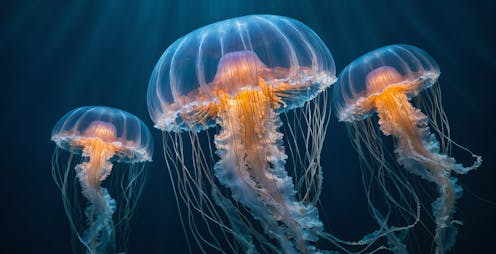
The world is gathering in Colombia for the UN biodiversity conference known as Cop16, a biannual pulse-taking of the living planet where actions to protect the natural world are agreed. At its last meeting in 2022, an ambitious roadmap for nature protection was put in place. As part of that Kunming-Montreal global biodiversity framework, the UN set a bold goal to protect 30% of the world’s land and ocean by 2030 – known as “30x30” – which was agreed by 196 countries and bodies such as the European Commission.
A key task in Colombia will be to measure progress, and the ocean is in the spotlight. A new report reveals that growth in marine protected areas – designated nature conservation zones that are protected from one or more harmful or damaging human activities – is far too slow to achieve this target. Analysis by conservation experts shows that protected areas are too scattered and unrepresentative.
Efforts to protect marine life lag far behind conservation on land. When 30x30 was agreed, the world had protected roughly 17% of land and 7.8% of the sea. The sea element was already behind previous targets, set in 2010 by the UN’s Convention on Biological Diversity to reach 17% and 10% protection of land and sea by 2020.
The 30x30 target is based on what scientists say is required to protect marine diversity, unlike the arbitrary 10% target it replaces. This would give a decent chance of meeting basic conservation goals like representing the full spectrum of habitats and species, or sustaining ecosystem services, such as the provision of seafood to eat and clean water for people. The 30x30 target was designed to turbo-charge conservation, end biodiversity loss and begin nature’s recovery. It hasn’t quite worked out that way, at least not yet.
The new report, commissioned by philanthropic initiative the Bloomberg Ocean Fund and developed in partnership with environmental organisations Campaign for Nature, the Marine Conservation Institute and SkyTruth, is sobering. Since 2022, the global ocean protected area network has grown by only 0.5 percentage points to 8.3%, still nearly 2% short of the 10% target that 30x30 replaced. On this trajectory, the world is set to crawl towards just 9.7% by 2030. The world is failing badly and there seems little urgency in the pace of progress.

Most marine protected areas (MPA) fail the quality test too. Assessed against a global framework of effectiveness, called the MPA guide, most marine protected areas are insufficiently protected or managed to deliver positive benefits to nature. The report calculates that only 2.8% of the world’s ocean is protected “effectively” according to MPA guide criteria. They include tiny protected areas like the South Arran MPA in Scotland, which was set up in 2014 and monitored by the local community, and the vast and still wild Ascension Island protected area that encloses 172,000 square miles (445,000km²) of the tropical Atlantic.
Even this low figure could overestimate current effectiveness. Reporting against MPA guide criteria is not yet mandatory for countries, so inconsistent definitions of protected areas complicate measurement of progress. And while some countries have declared MPAs as either “highly” or “fully” protected, the report suggests some of these areas aren’t sufficiently funded by governmental or other means to deliver effective management.
Country protected-area networks – that’s the the total composition of all protected areas – are badly imbalanced. In the global north, countries like the US, UK and France have declared large highly and fully protected areas in their overseas territories to boost the coverage of effective MPAs. Meanwhile, in home waters, most MPAs remain subject to destructive and extractive industrial activities such as bottom-trawl fishing or offshore energy. Their headline percentage protection numbers therefore “blue-wash” the reality of ongoing damage and biodiversity loss.
This October, Australia expanded the sub-Antarctic Heard and MacDonald Islands MPA, leading its environment minister to declare that with 52% of Australia’s waters protected, it had far exceeded 30x30. This and other huge offshore protected areas hide the fact that only 15% of coastal seas around the main Australian landmass are protected. Much of it is still open to industrial fishing and oil and gas production.
The 30x30 goal will also be an impossible dream until the world ratifies the UN’s high seas treaty. This was agreed in 2022 to manage and protect the colossal 61% of the ocean (43% of the Earth’s surface) that lies beyond the sovereign waters of any nation. Until that treaty comes into force, there is no agreed legal mechanism to create MPAs there. At present, just 1.4% of international waters are protected, much of them in Antarctica.
The Bloomberg report recommends governments speed up the creation of more marine protected areas. Another new study suggests a further 190,000 MPAs will be needed to reach 30x30, equivalent to 85 new protected areas daily for the rest of this decade.
While numbers and size matter, the world must also stop paying lip service to conservation and deliver real protection for nature, matched with sufficient and durable finance to ensure they work. And the high seas treaty needs urgently ratified, since there otherwise remains a near half-planet sized hole in ambitions for 30x30.

Don’t have time to read about climate change as much as you’d like?
Get our award-winning weekly roundup in your inbox instead. Every Wednesday, The Conversation’s environment editor writes Imagine, a short email that goes a little deeper into just one climate issue. Join the 40,000+ readers who’ve subscribed so far.
Callum Roberts receives funding from Convex Insurance, EU H2020, and EU Synergy. He is a board member of Nekton and Maldives Coral Institute, and advisor to Minderoo Foundation, Pew Bertarelli Ocean Legacy and CORDAP, and is a Pew Marine Fellow and WWF Fellow.
This article was originally published on The Conversation. Read the original article.







